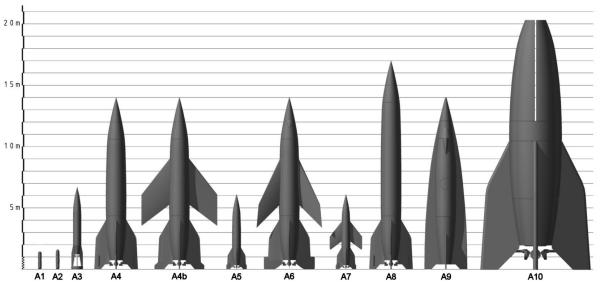
U.S. Manned Rocket Propulsion Evolution
Part 2.1: German V-2 Predecessors
Compiled by Kimble D. McCutcheon
Published 1 Nov 2020; Revised 03 Aug 2022
Abbreviations, Acronyms and Glossary
Introduction
The German A4 (later, and more commonly, V-2) was the world's first large guided missile. It was extremely complex and sophisticated for its time, requiring not only figuring out how to make the rocket work reliably and hit a target 200 miles away, but also planning the logistics and procedures for transporting the missile and its attendant equipment to pre-surveyed launch sites, via rail and truck, along with the ethanol fuel, liquid oxygen (LOX) oxidizer and hydrogen peroxide turbine propellant. The V-2 development team systematically solved numerous thorny problems and the resulting missile served as the ground work for future rocket propulsion development. As such, we shall explore the engineering challenges addressed during V-2 development in some detail.
Caveat: There is considerable data variation among V-2 sources. This author has tried to use hard data (dates, dimensions, metrics) from sources closest to the original development.
von Braun
Werner von Braun (23 Mar 1912 – 16 Jun 1977) received a special gift from his parents on his 13th birthday – a telescope. From that time forward he was obsessed with space and the idea of space exploration. Shortly thereafter, while in the German equivalent of American middle school, von Braun ordered a copy of Hermann Oberth's book Die Rakete zu den Planetenräumen (The Rocket into Interplanetary Space). When it arrived, he was disappointed to find it was filled with physics and mathematic formula; von Braun was a poor student of both subjects. However, he was inspired to study and eventually excel in the subjects. But his studiousness did not prevent him from conducting a series of dangerous and undisciplined chemistry and rocket experiments that set fires, damaged property and scared the citizens near his boarding school.
Rocket experimentation was becoming increasingly popular in Germany, and this led to the formation of the Verein für Raumschiffahrt (Society for Space Travel, VrR) on 5 Jul 1927. The VfR published a journal, Die RaketeI (The Rocket), which von Braun enthusiastically read and to which he ultimately contributed articles.
In late 1930, the VfR rented an abandoned munitions dump for its rocket experiments; this became known as the Raketenflugplatz (Rocket Aerodrome or Rocket Port), and became the central location for rocket experimentation. von Braun, now excelling in university engineering and mathematics, was a regular contributor. By the end of 1931, 279 engine tests and 87 launches had been accomplished. Then, in April 1932, three representatives from the German Army Ordnance ballistics and munitions section visited the Raketenflugplatz, an event that paved the way for von Braun's role in V-2 development. The Ordnance section arranged a research grant for von Braun, which he conducted at the Nazi Kummersdorf test site as he pursued his physics doctorate in Berlin. After securing some success with liquid-fueled rockets, he transferred to a new development and test site at Peenemünde on north German Baltic seacoast. [Neufeld]
By this time, von Braun had emerged as a gifted engineer, a charismatic leader and an enthusiastic voice for rocket development. He was obsessed with the idea of space exploration, an obsession that drove him over the course of his career to become the V-2 project technical director, a vocal advocate for space travel, the U.S. Army Ballistic Missile Agency technical director, and director of the U.S. National Aeronautics and Space Administration (NASA) Marshall Space Flight Center. We shall see numerous examples of his gift for identifying and channeling the skills of brilliant engineers and technicians, as well as securing the necessary political and cultural support, as this series progresses.
V-2 Missile Background
While at Kummersdorf, von Braun and his team designed the first two examples of the Aggregat (mechanism) liquid-fueled rocket series, designated A1 through A12.
 |
| Agregat Series A1 through A10 (Wiki) |
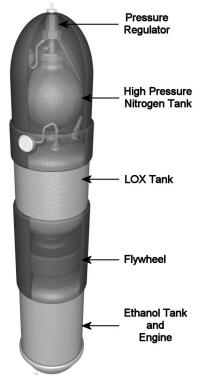 |
| The A2 |
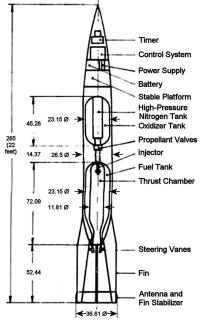 |
| The A3 |
The A1, which was 55” long, 12” in diameter and weighed 331 lb, was designed by von Braun in 1932 - 1933, and featured many characteristics of later rockets. The pressure-fed, regeneratively-cooled, 660 lbT engine, fueled by a 75% ethanol/water mixture and LOX oxidizer, burned for 16 sec, and was designed by Arthur Rudolph, who had become acquainted with von Braun through the VfR; Rudolph would continue his collaboration with von Braun all the way through the NASA Saturn V program. The water tended to produce a smoother burn, acted as a coolant, reduced the flame temperature, which lowered thermal stress. This engine was cleverly packaged inside the fuel tank to keep the thrust chamber cool. The A1 was successfully static test fired, but blew up on the launch pad during its first launch attempt on 21 Dec 1932 when a short ignition delay detonated an explosive propellant mixture that had accumulated in the thrust chamber. The team worried that A1 was nose-heavy and unstable due to the heavy flywheel stabilization package in its nose, so no second A1 was built. [Schulze, http://www.astronautix.com/a/a1.html, https://en.wikipedia.org/wiki/Aggregat_(rocket_family)]
The A2, which was 66” long and 12” in diameter and weighing 400 lb, solved the A1’s instability by moving the heavy flywheel from the nose to between the LOX and fuel tanks. The same Rudolph-designed engine was retained for the A2. Two A2 examples were built and successfully launched before German Army representatives on 19 and 20 Dec 1934 to altitudes of 1.4 and 2.2 miles. These successful tests resulted in a cash inflow, a new development and test facility at Peenemünde, and new missile designs. [Schulze, http://www.astronautix.com/a/a2.html, https://en.wikipedia.org/wiki/Aggregat_(rocket_family)]
The A3 was intended to bridge the gap between the A1, A2 and A4. Not only was it larger (22’ high x 2.2’ in diameter weighing 1,650 lb), but it was also intended to pioneer supersonic flight. As such it had a quirky set of smallish fins strengthened by an aft ring that also served as an antenna housing. It replaced the A2's flywheel with an inertial guidance system that controlled four molybdenum-tungsten vanes in the engine’s exhaust. The inertial guidance system consisted of three rate gyros to control attitude, and two spring-mass accelerometers with oil-damped integrators to measure pitch and yaw acceleration. The A3 was powered by another, larger, pressure-fed 75% ethanol/LOX engine producing 3,300 lbT. It used a new propellant injection scheme consisting of a mushroom-shaped central LOX injector whose flow streams impinged on circumferential alcohol streams; this was based on a design by Walter Riedel, another of von Braun’s VrR acquaintances. Liquid nitrogen was used for the first time to pressurize the fuel and LOX tanks, which reduced the size and weight of the pressurant tanks. Launches were attempted on 4, 6, 8 and 11 Dec 1937. Despite its ambitious goals, or perhaps because of them, none of the four A3 launches were successful; the newly-designed guidance system did not respond quickly enough to maintain trajectory control, causing premature parachute deployment or flight into the ground/sea. There were also problems with the engine and with the exhaust jet burning away the fins and stabilizer/antenna ring as the vehicle reached higher altitudes. [Schulze, Mueller, http://www.astronautix.com/a/a3.html, https://en.wikipedia.org/wiki/Aggregat_(rocket_family)]
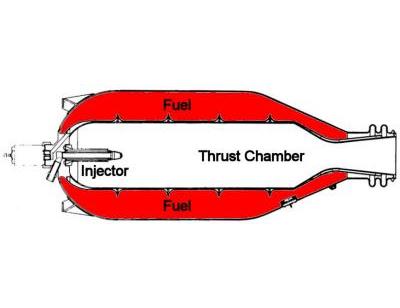 |
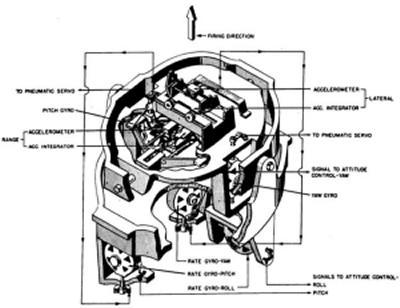 |
| A3 Fuel Tank and Thrust Chamber | A3 Guidance and Control Gyros and Accelerometers |
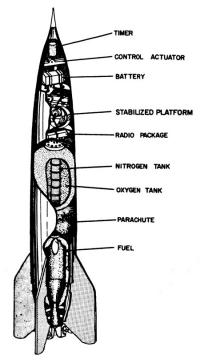 |
| The A5 |
The A5 was intended to sort out the A3’s problems, so work on the A4 was delayed while a new test articles were perfected. The goals of A5 included testing new fin designs, achieving supersonic speed, and testing a new guidance and control system.
While fin designs could be tested in Germany's single supersonic wind tunnel, the von Braun team decided the best way to test at supersonic speed was by using a number of low-cost A5 scale models. A powered A5 model series was contract-built by gas turbine and rocket pioneer Hellmuth Walter. These were 63” long, 7.87” in diameter, and weighed 103.6 lb. A 265 lbT monopropellant rocket engine was fueled by 85% hydrogen peroxide catalyzed by calcium, potassium or sodium permanganate, a reaction that produced very hot, high-pressure steam for 15 seconds. Experiments with the powered A5 models starting in September 1938 facilitated final development of the A5 fin planform. A number of unpowered scale A5 models were also produced, dropped from aircraft starting in September 1939, and helped perfect the fin design. These models were 63” long, 7.87” in diameter and weighed 551 lb.
The first full-sized A5, which was 19.09’ high, 2.55’ in diameter and weighed 1,980 lb, was launched on 1 Oct 1939. It used an A3 engine with a refined injector that, while still using 75% ethanol/LOX, produced 3,372 lbT for 45 sec. The A5 was equipped with new guidance and control systems from three different vendors. These were all capable of controlling attitude and executing a pre-programmed trajectory. The A3's molybdenum-tungsten guide vanes were replaces with ones made from graphite, still actuated by servos linked to the control system. Equipped with drogue and main parachutes, and capable of floating in water for about two hours, scores of A5s and A5 models were built; many were flown multiple times. [Schulze, Mueller, http://www.astronautix.com/a/a3.html, https://en.wikipedia.org/wiki/Aggregat_(rocket_family)]
The A4, based on success of the A5 program, allowed the development team to circle back to its original goal, a much larger missile (46.9' long, 5.4' in diameter and weighing 27,600 lb) intended to send a one metric ton (2,200 lb) warhead 200 miles, where it exploded upon contact with the ground. Unlike its predecessors, the A4 was not pressure fed, which meant its fuel and LOX tanks did not have to withstand nearly as much pressure and were built from a much lighter aluminum-magnesium alloy. The exterior structure, including the fins, was built in semi-monocoque aircraft fashion, except that its bulkheads, stringers and skin were of thin steel rather than aluminum alloy.
The A4 was fitted with another new guidance system based around the LEV-3 stabile platform, which consisted of two free gyroscopes, control potentiometers, pendulums, servo motors, mounting and adjustment provisions. One gyroscope controlled roll and yaw, while the other controlled pitch and included a tilt program, which established the trajectory climb angle. A Muller pendulous integrating gyroscopic accelerometer (PIGA) initiated the engine shut-down procedure when the programmed velocity was reached . Many A4s landed within 3.1 miles of target when launched from 125 miles away, and within 0.5 mile when a radio guide beam was used.
An even more accurate and sophisticated guidance and control system was developed late in the war; this formed the basis of systems that were later developed for a number of U.S. missiles and rockets.
As development neared completion, the A4 was redesignated Vergeltungswaffen-2 (retribution weapon 2), which was shortened to V-2. A total of 6,084 V-2s were built, and over 3,000 of these were launched at targets. The remainder was used for tests, training or was captured. As much of a leap forward as the V-2 was, its poor accuracy and high cost rendered it a tactical failure. Its real value was in blazing the way for future space rockets and missiles.
Near the end of WWII, von Braun surrendered to U.S. Forces, along with about 100 of his team and about 300 rail road cars of unfinished V-2 rocket parts, documents, and equipment. Over the next couple of years, the captured German team helped train U.S. Army, Air Force and industry personnel to assemble, maintain and operate the V-2. Components and documentation were also made available to U.S. manufacturers, providing them with a grounding in rocketry as well. Over 70 V-2 rockets were assembled and launched, mostly at the White Sands Proving Ground in New Mexico. These sounding rockets provided valuable data on the upper atmosphere and allowed experimentation with multi-stage rockets (Project Bumper), which could reach even greater altitudes. [Schulze, Mueller, http://www.astronautix.com/v/v-2.html, https://en.wikipedia.org/wiki/Aggregat_(rocket_family)]T.jpg) |
T.jpg) |
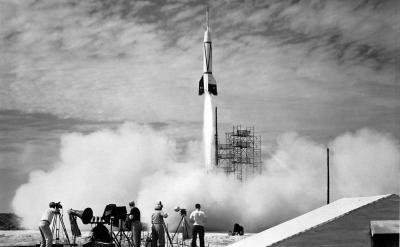 |
| The V-2 (heroicrelics.org) | The German Rocket Team at Ft. Bliss, Texas (heroicrelics.org) | Bumper WAC B-8, First Rocket Launched from Cape Canaveral, 24 Jul 1950 (Wiki) |
--- On To Part 2.2 ---